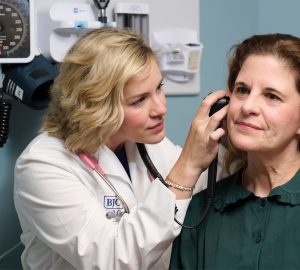Jillian seemed like a healthy 1-year-old—until the day she toppled over and couldn’t get up. Her right side was paralyzed, and a blank stare overtook her usually cheerful face. Tests eventually revealed she had a complex brain aneurysm. Without surgery, the growing aneurysm would rupture and Jillian would die. But her blood vessels were too small, and her aneurysm too complex, to be repaired by conventional methods.
Jillian’s terrified parents consulted experts nationwide. But only one had the skill to save their daughter: neurosurgeon Dr. Saleem Abdulrauf of SLUCare, the physicians of Saint Louis University. “Dr. Abdulrauf was so caring, he treated Jillian, Keith and I like family,” recalls Beth Bukowski of South Windsor, Conn. “He told us that living with an unstable aneurysm was far more dangerous than anything Jillian might face in an operating room.”
A standard treatment for large aneurysms is brain bypass surgery, in which an artery is removed from elsewhere in the body, connected to the carotid artery in the neck, and fed from the neck to the brain to maintain blood flow. The injured artery can then be clamped off. “But in Jillian’s case, two arteries branching off from the aneurysm were supplying the left side of her brain with blood,” recalls Abdulrauf, chairman of neurosurgery at Saint Louis University School of Medicine. “If we tried to close the aneurysm off, we would have shut down blood flow to her brain.”
Fortunately, Abdulrauf had developed an innovative way to perform the procedure. The high-flow brain bypass technique, known as the Abdulrauf bypass, is so intricate only a handful of surgeons have mastered it. “We took a healthy artery from her scalp and attached part of it to the side of one of the at-risk vessels,” Abdulrauf explains. He then attached the other end to the second compromised artery. With the two arteries safely connected to bypass the injured part of the vessel and a steady supply of blood to the brain ensured, he safely clamped off the aneurysm.
Jillian was the youngest patient ever to have a highflow bypass to two separate vessels in the brain. “She was off the ventilator within hours and out of the hospital in about a week,” Abdulrauf says. With no need to open the neck, the high-flow procedure is faster, less invasive and less risky than the standard technique, and requires less recovery time. “And because the procedure keeps more blood flowing than previous methods, the brain has a better chance of staying healthy,” he says.
Today, Jillian is a bright, loving 3-year-old with energy to spare. “I used to be afraid to look too far into the future, because I was so afraid my daughter was going to die,” Bukowski admits. “Now her father and I can hope again. We thank God every day for our baby’s life—and for the amazing Dr. Abdulrauf and his team.”
Photo by the Bukowski family
Pictured: Jillian Bukowski
[Dr. Saleem Abdulrauf of SLUCare, the physicians of Saint Louis University, has developed an innovative form of brain bypass surgery, known as the Abdulrauf bypass, that can save patients whose conditions were previously considered inoperable. To make an appointment, call 314.577.8849.]








